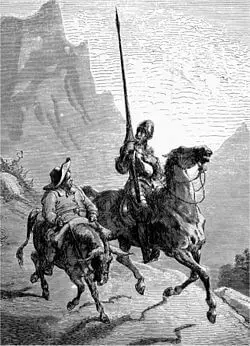To ’tilt at windmills’ is to attack imaginary enemies.
Tilting at windmills
What's the meaning of the phrase 'Tilting at windmills'?
What's the origin of the phrase 'Tilting at windmills'?
Tilting is jousting. The expression ’tilting at windmills’ derives from Cervantes’ Don Quixote – first published in 1604, under the title The Ingenious Knight of La Mancha.
The novel recounts the exploits of would-be knight ‘Don Quixote’ and his loyal servant Sancho Panza
who propose to fight injustice through chivalry. It is considered one of the major literary masterpieces and remains a best seller in numerous translations.
In the book, which also gives us the adjective quixotic (striving for visionary ideals), the eponymous hero imagines himself to be fighting giants when he attacks windmills.
Just then they came in sight of thirty or forty windmills that rise from that plain. And no sooner did Don Quixote see them that he said to his squire, “Fortune is guiding our affairs better than we ourselves could have wished. Do you see over yonder, friend Sancho, thirty or forty hulking giants? I intend to do battle with them and slay them. With their spoils we shall begin to be rich for this is a righteous war and the removal of so foul a brood from off the face of the earth is a service God will bless.”
“What giants?” asked Sancho Panza.
“Those you see over there,” replied his master, “with their long arms. Some of them have arms well nigh two leagues in length.”
“Take care, sir,” cried Sancho. “Those over there are not giants but windmills. Those things that seem to be their arms are sails which, when they are whirled around by the wind, turn the millstone.”
Apart from in medieval re-enactments, we don’t tilt in the sense of joust, any longer. These days ’tilting at windmills’ refers to attacks of a less militaristic nature.
The first figurative references to tilting at windmills, that is one where no jousting took place, came in the 17th century. John Cleveland published The character of a London diurnall in 1644 (a diurnall was, as you might expect, part-way between a diary or journal):
“The Quixotes of this Age fight with the Wind-mills of their owne Heads.”
The full form of the phrase isn’t used until towards the end of the 19th century; for example, in The New York Times, April 1870:
“They [Western Republicans] have not thus far had sufficient of an organization behind them to make their opposition to the Committee’s bill anything more than tilting at windmills.”
The history of “Tilting at windmills” in printed materials
Trend of tilting at windmills in printed material over time
Related phrases and meanings
Browse more Phrases
About the Author

Phrases & Meanings
A-Z
A B C D E F G H I J K L M N O P Q R S T UV W XYZ
Categories
American Animals Australian Bible Body Colour Conflict Death Devil Dogs Emotions Euphemism Family Fashion Food French Horses ‘Jack’ Luck Money Military Music Names Nature Nautical Numbers Politics Religion Shakespeare Stupidity Entertainment Weather Women Work
How did we do?
Have you spotted something that needs updated on this page? We review all feedback we receive to ensure that we provide the most accurate and up to date information on phrases.
